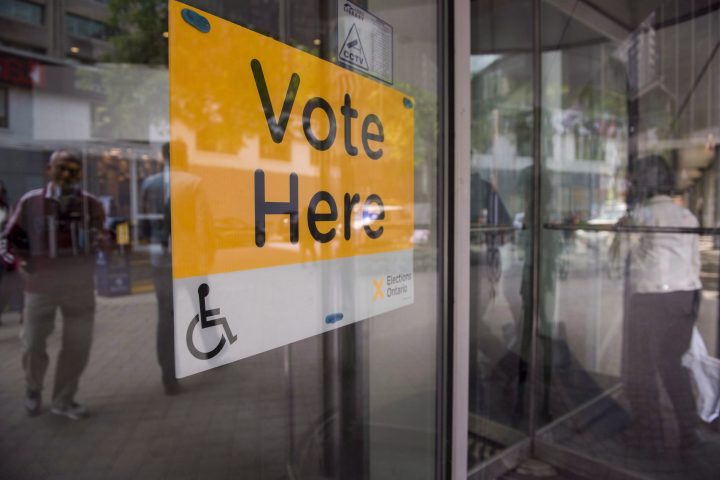There are several ways voters are able to cast a ballot in the Ontario provincial election.

Voting on June 2 — election day itself — is just one of the options.
Before then, electors can go to their local returning office, advance polling location, or vote by mail, among other options.
In order to vote, a person must be at least 18 years old on election day, a Canadian citizen and a resident of Ontario.
Here is a look at all of the different ways to vote, as highlighted on the Elections Ontario website:
Adding, updating, or confirming your voter information
Electors on the voters list will receive an information card sometime between May 12 and 20 with details on when and where to vote.
Electors can use the registration tool on the Elections Ontario website to add or update their information before May 23 in order to receive a voter information card. Voters can also update their information at a returning office or polling station.
If a voter receives an information card, they should bring it with them when they vote along with a piece of ID showing their name.
If a voter doesn’t get an information card, they may not be on the voters list but can still cast a ballot by bringing one piece of ID that has their name and current residential address.
- Alberta to overhaul municipal rules to include sweeping new powers, municipal political parties
- Canada, U.S., U.K. lay additional sanctions on Iran over attack on Israel
- Trudeau says ‘good luck’ to Saskatchewan premier in carbon price spat
- No more ‘bonjour-hi’? Montreal mayor calls for French only greetings
Electors can see their voting locations based on their postal code on the Elections Ontario website.
Election day
Polls will be open from 9 a.m. until 9 p.m. eastern time on June 2. Voters will be able to go to an assigned location based on their current residential address.
An election official will issue a ballot and voters can mark an X in the circle beside the name of their chosen candidate. In a voting location with tabulator technology, voters will place their marked ballot in a secrecy folder and take it to an election official operating the machine. If there isn’t a tabulator on site, voters will fold their ballot and place it into a ballot box themselves.
Advance polls
Between May 19 and May 28, voters can cast a ballot at an advance poll in their electoral district. They will be open from 10 a.m. until 8 p.m. eastern time.
Voters will be able to mark an X in the circle beside the name of their chosen candidate and return the ballot to the ballot box. Electors will place the marked ballot in a secrecy folder and hand it to an election official operating a tabulator.
Returning office
From May 5 until 6 p.m. eastern on June 1, voters can cast a ballot at their local returning office.
After completing an application form and taking a declaration, voters will be issued a special ballot which they will then complete and return to the ballot box.
By mail
The application to vote by mail opened on May 4. The deadline to apply is 6 p.m. eastern on May 27.
In order to vote by mail, electors have to complete an application and provide at least one piece of government-issued ID.
Voters can use the online application, or download and print an application which can then be submitted by email to sb@elections.on.ca or by mail to Elections Ontario, Special Ballot, 51 Rolark Drive, Toronto, Ontario M1R 3B1.
When printing an application, voters must submit the signed and completed form along with a copy of one government-issued ID or one government-issued proof of name and one proof of name and residence from a non-government entity, such as a pay stub or utility bill.
Once the application has been approved, a voting kit will be mailed to the address provided.
Those voting by mail can use the prepaid envelope to return their kit or they can drop it off at their local returning office.
The voting kit must be received by 6 p.m. eastern on June 2 in order to be counted.
Those outside of Canada will have to pay for the international postage.
Once a person successfully applies to vote by mail, they cannot vote via another option.
Students living away from home
Students living away from home and studying in Ontario are able to vote in the electoral district of either their home address or where they are studying school.
Elections Ontario says on-campus voting is only available for students living on campus.
Students studying outside of the province can vote by mail (either by applying through the process laid out above, or by registering as an absentee voter).
Home visit
If a voter is unable to go to a voting location because of a disability, is unable to read or write, can’t complete an application form, or requires assistance, they can request a home visit by contacting their returning office.
Two election officials will then bring a voting kit to assist the elector in voting.
Hospitals
Elections Ontario says it is holding a three-day hospital program, where officials will visit participating hospitals and bring voting kits to give those who are temporarily hospitalized the opportunity to cast a ballot.
Voters will have to show one piece of ID (a hospital bracelet can be used as proof of name and address) and complete the application form. They will then fill out a write-in ballot, fold it and place it in the envelopes as indicated before giving it back to the election officials.

Members of the Canadian Forces living outside of their electoral district
Members of the Canadian Forces and their family members living outside of their electoral district can vote by mail by applying through the process described above, or by registering as an absentee voter.
Those away in service of the government
Individuals and their family members who are away in service of the government can vote by mail by applying through the process described above, or by registering as an absentee voter.








Comments